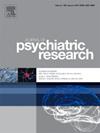Prevalence and association between emotional and behavioral problems and gaming disorder in children and adolescents——Evidence from 201,906 participants
IF 3.7
2区 医学
Q1 PSYCHIATRY
引用次数: 0
Abstract
Existing evidence suggested a potential link between mental health problems in children and adolescents and an increased odds of developing gaming disorder (GD). However, the relationship between emotional and behavioral problems (EBP) and GD remains unknown. This cross-sectional study, involving a sample size of 201,906 students aged 6–18 years from Guangzhou city, aims to investigate this association. The assessment of GD was performed using the Gaming Disorder Test, while EBP was evaluated via parent-reported Strength and Difficulty Questionnaire. Statistical analyses, including multiple logistic regression, subgroup analyses, and sensitivity analyses, were employed to examine the association between EBP and GD. The prevalence rate of GD was 11.4 %, with higher rates observed among adolescents and boys. After adjusting for covariates, children and adolescents with border or abnormal levels of total difficulties, internalizing problems, externalizing problems, emotional symptoms, conduct problems, hyperactivity/inattention problems, and pro-social behaviors exhibited a significantly increased odds of developing GD. This study suggests that Chinese children and adolescents with EBP may be more vulnerable to developing GD. Further longitudinal researches are needed to better understand this association.
儿童和青少年中情绪和行为问题与游戏障碍的患病率及其相关性——来自201,906名参与者的证据
现有证据表明,儿童和青少年的心理健康问题与患游戏障碍(GD)的几率增加之间存在潜在联系。然而,情绪和行为问题(EBP)与GD之间的关系尚不清楚。本横断面研究涉及广州市6-18岁的201,906名学生,旨在调查这种关联。GD的评估采用游戏障碍测试,EBP的评估采用家长报告的强度和难度问卷。采用多元逻辑回归、亚组分析、敏感性分析等统计分析,检验EBP与GD的相关性。GD的患病率为11.4%,其中青少年和男孩的患病率更高。在调整协变量后,总体困难、内化问题、外化问题、情绪症状、行为问题、多动/注意力不集中问题和亲社会行为的边界或异常水平的儿童和青少年表现出显著增加的发生GD的几率。本研究提示患有EBP的中国儿童和青少年可能更容易发生GD。需要进一步的纵向研究来更好地理解这种联系。
本文章由计算机程序翻译,如有差异,请以英文原文为准。
求助全文
约1分钟内获得全文
求助全文
来源期刊

Journal of psychiatric research
医学-精神病学
CiteScore
7.30
自引率
2.10%
发文量
622
审稿时长
130 days
期刊介绍:
Founded in 1961 to report on the latest work in psychiatry and cognate disciplines, the Journal of Psychiatric Research is dedicated to innovative and timely studies of four important areas of research:
(1) clinical studies of all disciplines relating to psychiatric illness, as well as normal human behaviour, including biochemical, physiological, genetic, environmental, social, psychological and epidemiological factors;
(2) basic studies pertaining to psychiatry in such fields as neuropsychopharmacology, neuroendocrinology, electrophysiology, genetics, experimental psychology and epidemiology;
(3) the growing application of clinical laboratory techniques in psychiatry, including imagery and spectroscopy of the brain, molecular biology and computer sciences;
 求助内容:
求助内容: 应助结果提醒方式:
应助结果提醒方式:


